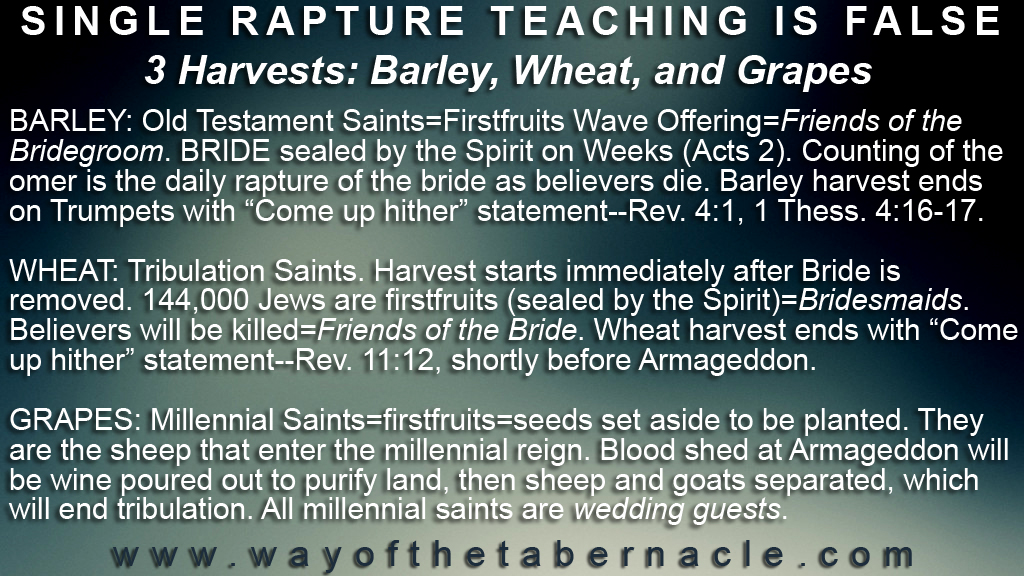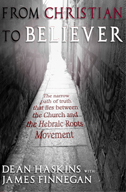FOR WHOM DID CHRIST DIE?
Ask most any christian this question, and the response will likely be something along the lines of “He died for the whole world,” or “He died for everyone.” That answer comes from something we have discussed many other times: spiritual ignorance caused by christianity's foolishly abolishing the Father's traditions, which, then, obscured many doctrinal truths.
And, because those spiritual truths were abandoned along with the traditions, most christians have no idea about many of these things, and simply believe teachings that are not based in truth, but on human ideas that are devoid of the Holy Spirit and His truths. So, let's look much more carefully at the question, and determine what the answer actually is, according to the Holy Spirit, His scriptures, and the Father's traditions.
Along with the spiritual discernment that is lost by not knowing or understanding the meanings within the Sabbaths (weekly and feasts), and the temple ordinances and practices (which foreshadow specific things about Messiah's bride), the Jewish wedding traditions are vital in grasping the entire scriptural narrative and focus.
You see, the whole of scripture presents a picture of Yah and His people, but more specifically, it presents all of the historical and prophetic steps leading to a wedding feast celebrating the marriage of Yah's Son, the Perfect Passover Lamb, to His bride.
In the Old Testament, we see myriad physical foreshadows that represent future-revealed spiritual real substances. In the physical vs. spiritual construct, the spiritual is always the real substance, and the physical merely presents a picture, or foreshadow, to aid in understanding the spiritual real substance.
The Jewish wedding traditions present the actual picture of Messiah Yahoshua's earthly ministry, crucifixion, resurrection, and the giving of the spiritual covenant. Along with the specific feasts involved, the wedding traditions, when properly understood, bring to life what actually occurred with Yahoshua's Passover sacrifice.
Herein, we will examine why Messiah's death was for His bride ONLY, and nobody else.
If one understands that the Old Testament account of the ancient Israelites receiving the covenant (Ten Commandments) is merely a physical foreshadow of Messiah's bride receiving the spiritual covenant (Acts 2), then what occurred throughout the Old Testament will make much more sense, and aid in grasping the scriptures as a single volume, and not two different volumes.
It is important to understand that the Holy Spirit didn't just show up in Acts 2, being previously absent from the world. No, the Holy Spirit has been alive and present with the Father and Son throughout all eternity—past, present, and future.
The difference with what happened in Acts 2 was the giving of the covenant, which is the pouring out of the Holy Spirit's SEAL upon the bride. Salvation did not begin in Acts 2, but has always been something given by the Father to those who believe in Him, and who endure in their belief.
During the Old Testament era, people were saved by their belief in Yah, not by their works, or by the written law. Salvation has always been salvation, and it has never been changed. Salvation has always been given by the Father as a result of a person's belief in Him.
The only difference that exists is that the bride is given the covenant, and that is the seal of the Holy Spirit, which means that, when one receives the covenant, he is eternally sealed by the Holy Spirit. Those in the Old Testament (before the spiritual covenant was poured out) were not sealed by the Spirit. So, if they fell away from their belief, they no longer had the covering of the Holy Spirit.
We see that exact departure of the Holy Spirit in the Old Testament accounts of King Saul and King Solomon. Both of them were given the Holy Spirit, but, because they turned away from their belief, and to disobedience and idolatry, the Holy Spirit was removed from them (1 Samuel 16:14, 1 Kings 11:9-13).
The same will be true of the tribulation saints and the millennial saints. Only those who endure in belief to the end will be saved. For the bride, “the end” represents when their eternity is sealed, for when the covenant is given, the end is declared, and the believer is granted eternal life.
To understand the importance of the covenant that is given to the bride, it is necessary to understand the Jewish wedding traditions, who the members of the wedding party are, and who the wedding guests are. So, let's dig in . . .
Members of the Wedding Party
Father of the Bridegroom - Yah
The Bridegroom – Messiah Yahoshua
The Bride – Y'isra-el, those indwelt by the spiritual covenant
Friends of the Bridegroom – Old Testament saints
Friends of the Bride – Tribulation saints
Shoshben (best man) – Elijah/John the Baptist (John 3:29)
Bridesmaids – 144,000 physical Jews sealed by the Spirit during the Tribulation
Wedding Guests
The wedding guests will be the millennial saints--those who are not deceived by Satan near the end of the 1000 years.
Elements of the Jewish Wedding
Ancient Jewish weddings came about differently than our modern marriages where a couple meets each other, falls in love, and chooses to be married. In the Jewish wedding, the father of the bridegroom would typically send a servant to a neighboring village to scope out the available young women.
When he found a girl he thought would be acceptable, he would make an offer of payment to the girl's father—the most his master could afford—and the girl's father could either accept or reject the offer. If he felt the offer was sufficient, he would tell his daughter about it, and she could either say “yes” or “no,” but typically, she would accept, as marriage opportunities might not be plentiful to her.
If the offer was accepted by the possible bride, the servant would leave part of the agreed upon price and return to his master to fill him in on the details. If the father was satisfied with the selection, his son would then go to meet the young lady who had been selected.
“For I am jealous over you with godly jealousy: for I have espoused (betrothed) you to one husband that I may present you as a chaste virgin to Christ.” (2 Corinthians 11:2)
The purpose for the son's first meeting of his future bride was to establish the legal parameters of the betrothal. In the ancient Jewish culture, being betrothed was to be legally married, but not yet being physically united. The betrothal period was typically between one and two years in length.
To fulfill the terms of the betrothal, a redemption price had to be paid for the bride, and a covenant given, whereby the bridegroom would agree to provide support for his betrothed bride during the separation period. Once the agreement was made and the redemption price paid for the bride, the bridegroom would publicly announce that the redemption had been paid in full by declaring “It is finished.”
So when Yahoshua had received the sour wine, He said, “It is finished!” And bowing His head, He gave up His spirit. (John 19:30)
Once the redemption price (mohar) was paid, and the terms of the covenant (ketubah) agreed to, the bridegroom would make a speech of promise, wherein he would tell his betrothed bride that he was going to go back to his father's house to prepare a dwelling place for them, which included a wedding chamber (chuppah) where their marriage would be consummated. This began a period of mandatory separation.
During the separation, the two could have no physical contact with each other. This is where we get our modern tradition of the bride and groom not seeing each other on their wedding day until the actual ceremony.
“In My Father’s house are many dwelling places; if it were not so, I would have told you; for I go to prepare a place for you. If I go and prepare a place for you, I will come again and receive you to Myself, that where I am, there you may be also.” (John 14:2-3)
Once the bridegroom left to go back to his father's house, it was the father alone who determined exactly when his son would go and retrieve his bride. It was the father alone who would state that the dwelling place was sufficiently built and furnished, and then he would tell his son to go and get his bride.
Messiah Yahoshua detailed for His disciples the series of events that would lead to His second return to the earth to reign from Jerusalem for 1000 years. And, the singular event that begins those things will be the bride's removal from the earth, at which time she will be taken to the wedding chamber (chuppah).
Now, remember, it is the Father who determines when the Son is to go and bring His bride back to the wedding chamber; and, Messiah told His disciples, “But of that day or hour no one knows, not even the angels in heaven, nor the Son, but the Father alone” (Mark 13:32).
The Jews called the Feast of Trumpets by different names—they called it “the day or hour no one knows,” because it is the only feast that falls on the sighting of the new moon, which could be hindered because of weather. They also called it “the last trump,” because on the new moon of the first month, the trumpet would be blown once. And then, for the next five months (six in total), the same single trumpet blow would occur on each new moon.
But, the new moon that begins the seventh month is the Feast of Trumpets, and the high priest would SHOUT for the trumpet to be blown 100 times, with the final blow being the loudest and longest. See 1 Corinthians 15:52 (the last trump) and 1 Thessalonians 4:16-17 (the feast of the shout). Both of those passages speak of the Feast of Trumpets, which the Jews also called “the wedding of Messiah.” How can one have a wedding without a bride?
The Feast of Trumpets also begins the fall feasts, which are called “the judgment feasts.” Remember, Yah judges His house (Y'isra-el) first—1 Peter 4:17.
So, the Holy Spirit gives us clues in the scriptures that the bride will be removed on the Feast of Trumpets, which is the next feast to be fulfilled on the prophetic calendar (Passover, Unleavened Bread, Firstfruits, and Weeks have already been fulfilled by Messiah's crucifixion, burial, and resurrection, and the giving of the covenant).
It is important to understand that, contrary to what most christian teachers claim (because of ignorance of the traditions), the bride will NOT return with Messiah Yahoshua when He comes back to earth on the Feast of Atonement, and sets up His millennial kingdom where His millennial temple will be dedicated on the Feast of Tabernacles.
It will be the friends of the Bridegroom (Old Testament saints) and the friends of the bride (tribulation saints) who return with Him, as they have been promised to rule and reign with Him on the earth for 1000 years (Revelation 20:4-6). Messiah's bride Y'isra-el will rule and reign with Him in eternity as the wife of the King of heaven and earth.
According to the traditions, when the bride is taken to the wedding chamber by the bridegroom and the best man (shoshben), the best man stays outside the chuppah waiting to hear the bridegroom call out to him that the marriage has been consummated (John 3:29), at which time, the best man would go and tell the rest of the wedding party (friends of the bridegroom and friends of the bride) to start preparing the wedding feast.
The bride would stay in the wedding chamber until the beginning of the feast, at which time, she would be revealed, which is what we see in Revelation 21:2. Once the bride had been betrothed, she would be veiled every time she went into the public square. Only her family and closest friends knew who she was. She was revealed to everyone at the wedding feast.
It might seem like a thousand years will be a long time to wait to be revealed, but remember, in heaven, a thousand years is as a day (2 Peter 3:8). The wedding feast is actually eternity, which will be a never-ending celebration.
Now, back to the main topic mentioned at the beginning: for whom did Christ die? His death was the redemption price FOR HIS BRIDE. The Passover sacrifice is tied to the covenant, as covenants were sealed with blood (during the OT, covenants would be sealed with the blood of sacrificed animals).
As Messiah said during His last Seder, “For this is My blood of the new covenant, which is shed for many for the remission of sin” (Matthew 26:28). And, that new covenant was given on the same day the old covenant had been given (Ten Commandments), which was the Feast of Weeks (Acts 2), seven Sabbaths plus one day from the Feast of Firstfruits.
In a marriage, to whom is the covenant given? It is not given to the friends of the Bridegroom. It is not given to the friends of the bride. It is not given to the wedding guests. No, it is given to the bride alone. The new covenant, given to Messiah's bride, is the seal of the Holy Spirit. Once one is sealed by the Holy Spirit, he HAS eternal life—the Holy Spirit cannot EVER be removed from one who is sealed.
The Old Testament saints were not sealed—the Holy Spirit could be removed from them. The tribulation saints are not sealed by the Holy Spirit either. They will have to endure to their deaths to be covered by the Holy Spirit.
But, there is one exception, and that is the 144,000 physical Jews who will be sealed like the bride was; but they are not the bride—they are the bridesmaids. Bridesmaids support the bride, and we see the 144,000 inside the New Jerusalem, which is the bride. They are pillars in the New Jerusalem, and pillars provide support (Revelation 3:12).
Their presence as part of the New Jerusalem is the final fulfillment of Ephesians 2—the two groups (physical Jews and Gentiles) being brought together as one.
Salvation has always been salvation, and will always be salvation; and, it is by belief alone. BUT, it is only the bride who is given the covenant of marriage, and Messiah's crucifixion was the redemption price paid for His bride, and provided the blood that sealed the covenant given to her.
Thus, Messiah was crucified to redeem His bride. Nobody else. Only His bride, who is the New Jerusalem. The bride was symbolized by the Ark of Covenant, and Messiah was symbolized by the Mercy Seat atop the Ark.
The Holy Spirit is associated with the bride (Y'isra-el), and the glory of the Father indwells the New Jerusalem. This is pictured by the matzah tash in the Seder—the three-pouched linen cloth into which are placed three loaves of unleavened bread.
Yah, Yahoshua, and Y'isra-el all dwelling in Yah's house for eternity, and the glory of the Father will shine out of the New Jerusalem onto the new earth below it, where the rest of heaven's inhabitants will dwell.

Written by Dean Haskins for Way of the Tabernacle. Reproductions with proper attribution are allowed and encouraged.
Salvation
Traditions
Other Truths
But now in Yahoshua the Messiah you who formerly were far off have been brought near by the blood of Christ. For He Himself is our peace, who made both groups into one and broke down the barrier of the dividing wall, by abolishing in His flesh the enmity, which is the Law of commandments contained in ordinances, so that in Himself He might make the two into one new man, thus establishing peace, and might reconcile them both in one body to Yah through the cross, by it having put to death the enmity. Ephesians 2:13-16




